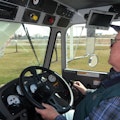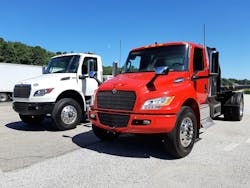International eMV Drives Like a Diesel
Manufacturers are touting electric trucks, and the media are shining attention on them. Whether or not they make operational or financial sense at this time, the day may come sooner than a lot of folks think. E-trucks are now available for sale and yes, they are entirely usable.
For an inside look at the International eMV, go to the photo gallery.
An example is this International eMV, the electric version of the builder’s ubiquitous diesel-powered medium-duty trucks. It’s one of 125 that International had built by December, 30 of which are in service, most with van or boom bodies. I took this one around the Navistar Proving Grounds in northern Indiana and found the viper red utility truck easy and fun to drive. It drove a lot like a diesel version.
Bruce Vasbinder, director of medium-duty segment marketing for Navistar International, suggested I first take the standard International MV out onto the 2.5-mile paved track. I did, and it drove and handled as I expected: gutsy performance from the Cummins B6.7 diesel and an Allison 3000 series automatic transmission, a good seating position, and plenty of room in the steel cab. I parked that truck, and then we approached the eMV.
Diesel v. electric truck
“A guy getting into the eMV is not going to feel like it’s anything foreign,” said Vasbinder. “The cab is the same except for the gauge cluster, which is digital on the eMV” rather than the standard electro-mechanical gauges in the MV. The cab is a steel fabrication with more than ample room and large windows for good outward visibility. The glowing digital gauges are behind an oblong plastic window. Gauge design is purposely familiar, with a battery charge gauge showing an “empty” to “full” range instead of “percent of charge” or something that might give a driver pause.
The eMV’s chassis is also from the diesel series. A leaf-spring suspension in front and air suspension in the rear deliver a decent ride and ably support the truck and its load. Designers used a heavy Class 7 frame to tote the six lithium-iron-phosphate batteries, which together weigh 3,300 pounds. Right there is one of the e-truck’s drawbacks: It scales about 1,700 pounds more than the diesel, even subtracting the mass of a diesel and transmission. That of course cuts into payload, which usually wouldn’t be much of a problem with this truck’s intended duty as a utility vehicle, hauling materials and supplies and sometimes a load of gravel or rock that could be dumped into a trench. There are several eMVs now in operation doing this type of work, Vasbinder said.
Driving it is similar to operating the diesel, but without the internal combustion rumble from under the hood and extra retarding through regenerative braking that sends electricity to the batteries. It’s quiet outside or inside the cab, though any squeaks or rattles might become more irritating than if there were a diesel to drown them out; this cab was tight, but it had few miles on its odometer. Road and tire sounds are present, but any whine from the electric motor is muted because the motor is at the very rear of the truck, under the flatbed body, instead of somewhere in the driveline as on other electric trucks. The motor drives the rear axle via a driveshaft about 4 feet long; the differential faces the rear to accept power and torque input. This simple arrangement speeded engineering and initial production.
The rear motor adds some weight where it’s useful when the body is empty, but it also limits rearward placement of the drive axle and stretches the AF (rear axle to rear of frame) measurement, Vasbinder said. This works for a utility truck but not for a dumper, which needs that axle as far to the rear as possible to provide stability while tipping the box. That’s why future eMVs will use “e-axles,” with motors mounted directly on the differentials. Dana now makes these, and the Dana motor has been used in machinery of various sorts for more than two decades. An e-axle can also incorporate a 2- or 3-speed gearbox to reduce the motor’s revs and expand its operating range. As it is, the rear motor on the eMV has no transmission, so it operates as a single-speed unit; it can launch a 33,000-pound truck on an 18-percent upgrade and travel on a highway at up to 62 mph.
On level pavement, the motor’s bountiful torque—up to 1,700 lb.-ft. but electronically limited to match a diesel’s torque curve—launched the truck with authority, and acceleration was brisk, which is a pleasing feature of most electric cars and trucks I’ve driven. And 62 on the speedometer felt like the governed top speed as we cruised around the paved track. Between those speeds, the truck was quick and agile, or as much as a Class 7 vehicle can be. E-trucks are fun to drive, as operators of other e-trucks now in service enthusiastically testify, and that should boost recruiting efforts. The lack of noise and vibration will probably reduce wear and tear on a driver’s ears and perhaps the rest of their body, and that would have to reduce health-care costs.
Terex and Altec, two major makers of boom-bucket utility bodies, are enthusiastic about the eMV and have placed standing orders for 30 chassis a month between them, Vasbinder said. Their public-utility customers are understandably anxious to acquire electric-powered “trouble trucks” for image enhancement and for practical reasons: E-trucks have fewer parts than diesels, and after all, these companies make the energy that drives them. Use of Dana e-axles and lighter-weight batteries—perhaps using nickel manganese cobalt chemistry—will widen the potential for the eMV. “Grow the technology and grow the applications,” Vasbinder said. Electric-powered heavy dump trucks are one possibility, and they might be five years in the future, or less.
Before operators even consider buying electric trucks, however, they must arrange financing and figure out how and where they’re going to “fuel” them during off hours: What kind of charging equipment will they need, where will chargers be mounted, and can local electric utilities supply enough power during times when the trucks are to be plugged in? Alternatives are wind or solar generation at customers’ locations. Navistar and other e-truck builders can offer advice on how to obtain government grants to offset the higher upfront cost—twice that of a diesel truck—and begin planning for the charging infrastructure. Electric propulsion is the future, but meanwhile, don’t sell diesels short: They’ll be around well into the 2030s.
International eMV Test Specs
Truck: International eMV (MV60E), electric-powered conventional-cab straight truck, BBC 107.9 in., w/ 10.375-in.-high frame rails, GVW rating 33,000 lb.
Electric drive system: 608-volt Dana TM4 SUMO HP, w/ 577-hp/1,700-lb.-ft. motor (electronically limited to 335 hp/738 lb.-ft.)
Front axle: 12,000-lb. Dana Spicer D1201R on parabolic taperleafs, w/TRW Ross TAS66 power steering
Rear axle: 23,000-lb. Dana S23-172F w/ 6.83 ratio, on International IROS air-ride
Wheelbase: 217 in.
Brakes (front and rear): Bendix Spicer ADB22X air discs
Tires & wheels: 11R22.5 Continental EcoPlus HS3+ on Accuride polished aluminum discs
Body: 14-ft. Crysteel Rugby
About the Author

Tom Berg
Tom Berg is widely acknowleged as one of the top truck writers in the industry. He has covered construction for more than 34 years, and has test-driven well over 150 trucks for Construction Equipment.
